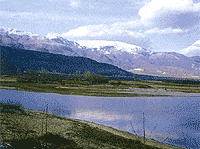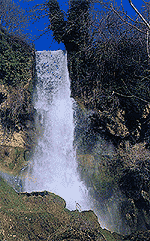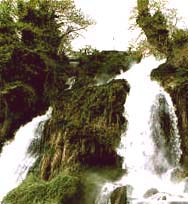The capital of this prefecture is Edessa, built in the foothills of Mt. Vermion, with a view over the plain, lush greenery, flower – filled gardens and plenty of water. Edessa’s celebrated waterfall is to be found to the northeast of town, in a thickly wooded area with a stunning view. Under the largest cataract there is a small cave with a chapel dedicated to the Ascension (Analipsi).
Edessa’s celebrated waterfall is to be found to the northeast of town, in a thickly wooded area with a stunning view. Under the largest cataract there is a small cave with a chapel dedicated to the Ascension (Analipsi).  Five kilometers from here is the village of Agras, which took its name from the Macedonian warrior Tellos Agras. One of Greece’s biggest hydroelectric plants is located here. The lake that feeds the plant, which covers an area of 1,000,000 sq. m., has become a habitat for wild ducks and swans.
Five kilometers from here is the village of Agras, which took its name from the Macedonian warrior Tellos Agras. One of Greece’s biggest hydroelectric plants is located here. The lake that feeds the plant, which covers an area of 1,000,000 sq. m., has become a habitat for wild ducks and swans.
A town famed for its fruit and red peppers is Aridea, while Skidra is considered among the largest fruit-producing centres of Greece.
Another town with an abundance of water is Arnissa, built on the lower slopes of Kaimaktsalan, in front of the lake Vegoritis.
Finally, we have Gianitsa, the biggest city in the prefecture and an important agricultural and animal breeding center.
The villages of Palia & Nea Pella lie just 4 kilometers away, with the ruins of ancient Pela spead out between them. It was here that during the reign of Archelaos (413-399 B.C.) that Pella became the capital of the Macedonian kingdom. He built a new palace and invited Zeuxis, the greatest painter of the day, to decorate it. Both Philip II and Alexander the Great spent some time here.
By the 4th century B.C., the new capital had become the most important political, economic and administrative center of the Macedonian Kingdom.
Excavations here have unearthed portions of the walls, the palace, the sanctuaries of Aphrodite, Demeter and Cybele, the marketplace, cemetery and several houses. In two of these houses, which date to the late 4th century B.C., mosaic floors of exceptional quality have been found; they are perhaps the finest examples of the art yet discovered (on display in the museum).
 Edessa’s celebrated waterfall is to be found to the northeast of town, in a thickly wooded area with a stunning view. Under the largest cataract there is a small cave with a chapel dedicated to the Ascension (Analipsi).
Edessa’s celebrated waterfall is to be found to the northeast of town, in a thickly wooded area with a stunning view. Under the largest cataract there is a small cave with a chapel dedicated to the Ascension (Analipsi).  Five kilometers from here is the village of Agras, which took its name from the Macedonian warrior Tellos Agras. One of Greece’s biggest hydroelectric plants is located here. The lake that feeds the plant, which covers an area of 1,000,000 sq. m., has become a habitat for wild ducks and swans.
Five kilometers from here is the village of Agras, which took its name from the Macedonian warrior Tellos Agras. One of Greece’s biggest hydroelectric plants is located here. The lake that feeds the plant, which covers an area of 1,000,000 sq. m., has become a habitat for wild ducks and swans.A town famed for its fruit and red peppers is Aridea, while Skidra is considered among the largest fruit-producing centres of Greece.
Another town with an abundance of water is Arnissa, built on the lower slopes of Kaimaktsalan, in front of the lake Vegoritis.
Finally, we have Gianitsa, the biggest city in the prefecture and an important agricultural and animal breeding center.
The villages of Palia & Nea Pella lie just 4 kilometers away, with the ruins of ancient Pela spead out between them. It was here that during the reign of Archelaos (413-399 B.C.) that Pella became the capital of the Macedonian kingdom. He built a new palace and invited Zeuxis, the greatest painter of the day, to decorate it. Both Philip II and Alexander the Great spent some time here.
By the 4th century B.C., the new capital had become the most important political, economic and administrative center of the Macedonian Kingdom.
Excavations here have unearthed portions of the walls, the palace, the sanctuaries of Aphrodite, Demeter and Cybele, the marketplace, cemetery and several houses. In two of these houses, which date to the late 4th century B.C., mosaic floors of exceptional quality have been found; they are perhaps the finest examples of the art yet discovered (on display in the museum).
Edessa
The name Edessa is related to the ancient Phrygian and means tower in the water or town on the water. In 814 BC Heraklides "Karanos" makes it the first kingdom of Macedonians and the fate of the city is identified with the history of Macedonia. Ancient, byzantine but also industrial finds, testify the town's history. Romans, Slavs, Ottomen as well as occasionals pass from its history.
 On 18th October 1912 the town was liberated and incorporated to the Hellenic State as capital of the prefecture of Pella. In 1923 it is supported by Greeks-refuges from Asia and only after the '50s - '60s when the "white coal" (=water) becomes useless which for centuries had moved mills, workshops, industries and factories. This was the end of the indrustry and industrial history of the city. Many people of 'culture' have their name connected with the town.
On 18th October 1912 the town was liberated and incorporated to the Hellenic State as capital of the prefecture of Pella. In 1923 it is supported by Greeks-refuges from Asia and only after the '50s - '60s when the "white coal" (=water) becomes useless which for centuries had moved mills, workshops, industries and factories. This was the end of the indrustry and industrial history of the city. Many people of 'culture' have their name connected with the town.
The waterfalls of Edessa didn't use to be the same as they are now. Until the end of the 14th century the main volume of the water was held in a small lake in the west of the town.
Then the waters (perhaps after a geologic or weather phenomenon) decide to pass the town and to fall thematical from its rock, as a result creating many small rivers and at the same time the lake from where they were from came to an end. Many travellers of the 17th and 18th century describe the picture of the town with arock from which water falls of a lot of waterfalls.
For nowadays traveller it would be difficult to understand what happened a few decades ago, when the waterfalls was an unknown place. They were hidden behind high grass, behind irrepressable vegetation, abandonned at the edge of the rock, it was considered to be a venture or even an adventure to walk down the rough paths of those days to watch them ... or to take a picture of them.
 From 1942 there is a different confrontation of the whole place and the first Germans see it with a touristic and of usage view. Each mornimg the sergeant of the Gestapo Fritz blocked the ways to the square, took away the identity cards of the men and if they wanted to get them back they had to give a hand at the work-site at the waterfalls. So in summer, in 1942, two swimming pools, parterres, flower-stands sprong out of nowhere. We could say now that they were built with an interesting architecture which respects the landscape.
From 1942 there is a different confrontation of the whole place and the first Germans see it with a touristic and of usage view. Each mornimg the sergeant of the Gestapo Fritz blocked the ways to the square, took away the identity cards of the men and if they wanted to get them back they had to give a hand at the work-site at the waterfalls. So in summer, in 1942, two swimming pools, parterres, flower-stands sprong out of nowhere. We could say now that they were built with an interesting architecture which respects the landscape.
After the end of the war, the place was given to the municipality of Edessa and the gardeners looked after it, planted in it many flowers and trees. Then the civil war broke out and the waterfalls were forgotten for same time, except the farmers of "Loggos" district who enjoyed having their bath there. They were hard working people who had never seen the sea, got off their mule and dived into the cold green waters.
Until the beginning of the 1960's paths were under construction so that the tourists could get to the waterfalls safely that time the places "Belventere" were constructed to have a variety of views. There was an exception however, the desicion of the electric civil service to built another small factory, destroying the waterfalls park and the waterfalls as well. This idea didn't work out because people of the town became stabborn and fought back so they SAVED the waterfalls after many fights, the matter of course and the manifest.
Today the waterfalls are a well-known site of the immensity beaty for whole Greece and all the rest world. Anyone can safety admire the big waterfall named "KARANOS" and the double's. The water falls from 70 meters height and there is a small cave under the rock.
The whole area has been upgraded and offers many facilities to the tourists Indicatively, it is reported that there is a tourist information office continiously open as well as the Open Air Water Museum (Industrial Museum with watermills - factories) and a 5* hotel with a convetion center amd other facilities.
 On 18th October 1912 the town was liberated and incorporated to the Hellenic State as capital of the prefecture of Pella. In 1923 it is supported by Greeks-refuges from Asia and only after the '50s - '60s when the "white coal" (=water) becomes useless which for centuries had moved mills, workshops, industries and factories. This was the end of the indrustry and industrial history of the city. Many people of 'culture' have their name connected with the town.
On 18th October 1912 the town was liberated and incorporated to the Hellenic State as capital of the prefecture of Pella. In 1923 it is supported by Greeks-refuges from Asia and only after the '50s - '60s when the "white coal" (=water) becomes useless which for centuries had moved mills, workshops, industries and factories. This was the end of the indrustry and industrial history of the city. Many people of 'culture' have their name connected with the town. The waterfalls of Edessa didn't use to be the same as they are now. Until the end of the 14th century the main volume of the water was held in a small lake in the west of the town.
Then the waters (perhaps after a geologic or weather phenomenon) decide to pass the town and to fall thematical from its rock, as a result creating many small rivers and at the same time the lake from where they were from came to an end. Many travellers of the 17th and 18th century describe the picture of the town with arock from which water falls of a lot of waterfalls.
For nowadays traveller it would be difficult to understand what happened a few decades ago, when the waterfalls was an unknown place. They were hidden behind high grass, behind irrepressable vegetation, abandonned at the edge of the rock, it was considered to be a venture or even an adventure to walk down the rough paths of those days to watch them ... or to take a picture of them.
 From 1942 there is a different confrontation of the whole place and the first Germans see it with a touristic and of usage view. Each mornimg the sergeant of the Gestapo Fritz blocked the ways to the square, took away the identity cards of the men and if they wanted to get them back they had to give a hand at the work-site at the waterfalls. So in summer, in 1942, two swimming pools, parterres, flower-stands sprong out of nowhere. We could say now that they were built with an interesting architecture which respects the landscape.
From 1942 there is a different confrontation of the whole place and the first Germans see it with a touristic and of usage view. Each mornimg the sergeant of the Gestapo Fritz blocked the ways to the square, took away the identity cards of the men and if they wanted to get them back they had to give a hand at the work-site at the waterfalls. So in summer, in 1942, two swimming pools, parterres, flower-stands sprong out of nowhere. We could say now that they were built with an interesting architecture which respects the landscape.After the end of the war, the place was given to the municipality of Edessa and the gardeners looked after it, planted in it many flowers and trees. Then the civil war broke out and the waterfalls were forgotten for same time, except the farmers of "Loggos" district who enjoyed having their bath there. They were hard working people who had never seen the sea, got off their mule and dived into the cold green waters.
Until the beginning of the 1960's paths were under construction so that the tourists could get to the waterfalls safely that time the places "Belventere" were constructed to have a variety of views. There was an exception however, the desicion of the electric civil service to built another small factory, destroying the waterfalls park and the waterfalls as well. This idea didn't work out because people of the town became stabborn and fought back so they SAVED the waterfalls after many fights, the matter of course and the manifest.
Today the waterfalls are a well-known site of the immensity beaty for whole Greece and all the rest world. Anyone can safety admire the big waterfall named "KARANOS" and the double's. The water falls from 70 meters height and there is a small cave under the rock.
The whole area has been upgraded and offers many facilities to the tourists Indicatively, it is reported that there is a tourist information office continiously open as well as the Open Air Water Museum (Industrial Museum with watermills - factories) and a 5* hotel with a convetion center amd other facilities.

